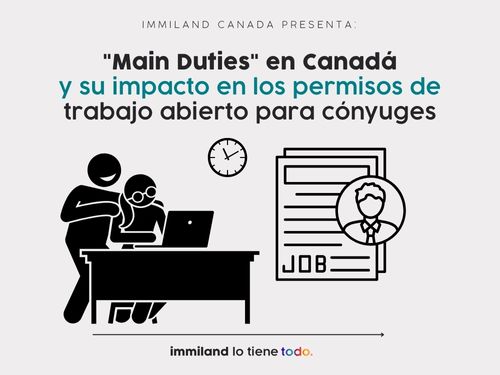"Main Duties" in Canada and their impact on open work permits for spouses.

.jpg)
Did you know that many rejections on open work permits for the couple in Canada occur because of a poor substantiation of the Main Duties?
In January 2025, there was a significant change in Canadian immigration policies and, since then, in order for the partner of a graduate student or worker with a closed work permit to apply for an open work permit, the principal person (the student or worker) must have a qualifying offer of employment. That is, of TEER level 0, 1 (any occupation on the list), 2 or 3 (specific occupations on the list).
Even with this requirement, many open work permits for the couple are being rejected, but why? what exactly is going on? The reason lies in an incorrect substantiation of the job functions. If this is your case, read to the end so you can avoid these mistakes. Let's get started.
The importance of substantiating "Main Duties" to avoid work permit rejections
In Canada, "Main Duties" are the most important responsibilities and tasks of a job, as described in the government's official occupation classification system, known as NOC (National Occupational Classification).
NOCs not only have a job title, but also include a detailed list of the functions that most workers in that occupation perform. These functions are what define the position, even if your job title is different.
What does an immigration officer do with "Main Duties"?
Main Duties are essential in the immigration process. An immigration officer not only looks at your job title to determine if you meet the requirements, but compares theMain Duties of your actual job to those listed on the NOC. This means that the following must be met:
- Eligibility verification: if you wish to apply to an immigration program that requires a specific type of work, you must demonstrate that your job duties are those described by the government for that NOC.
- The 80% rule: for your profile to be considered eligible, your job responsibilities (presented in your job letter or confirmation of employment) are expected to match at least 80% of the NOC's primary duties.
In short, the "Main Duties" are the basis of your job profile for the Canadian government. Your job title may be "Assistant Manager", but if your main duties are those of an "Accountant", your actual NOC will be Accountant. The government focuses on what you do, not what your job title is called.
The cause of rejections
The primary reason for these rejections lies in a deficiency in the substantiation of the application for failure to meet the "Main Duties". Despite meeting the TEER 0, 1, 2 or 3 requirement of your job offer, the officer will reason that, although your job is eligible by name, in practice it is not eligible by the nature of your duties.
It is important that the applicant knows how the analysis of his profile works and that he is aware that what defines his position is not the title, but the functions he performs.
Steps to avoid rejection
To ensure that your partner's application is successful, follow these tips:
- Search for your position on the official Government of Canada website and verify your level (TEER 0, 1, 2 or 3). Make sure that your current position or job offer corresponds to an eligible NOC code.
- Review the "Main Duties" of your NOC and ensure that the duties detailed in your offer letter or job confirmation letter, if you are already employed, match at least 80% of the government descriptions.
- Check the TEER 2 and 3 lists. You need to verify that the position is specifically included in the lists of occupations that the government has published. If it is not, your partner will not be eligible for an open work permit, even if the job is skilled.
- If the TEER is 0 and 1, you do not need to check the list, as all occupations at these levels are eligible.
In this video, you will find a practical example of how to analyze your profile.
Doing this research and making sure your job offer not only has the right title, but also the right duties is critical to securing approval for your partner's open work permit.
I hope this topic will clarify your doubts on how to successfully obtain the open work permit for the couple.
If you would like an immigration consultation to evaluate your case and improve your chances of approval, you can contact us and an Immiland Canada CICC regulated lawyer or consultant will guide you through the process.
Visit our website: https://www.immilandcanada.com/migracion/inicio and explore visa refusal services and more.
Thank you for reading us, success in your process!
With love,
Immiland Canada
Note: This article does not constitute legal advice or legal opinion from an attorney. Rather, it is provided solely to inform readers about certain aspects related to the details of the law in legal matters.








.jpg)















.jpg)